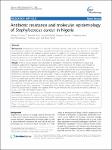Antibiotic resistance and molecular epidemiology of Staphylococcus aureus in Nigeria
Shittu, Adebayo
Okon, Kenneth
Adesida, Solayide
Oyedara, Omotayo
Witte, Wolfgang
Strommenger, Birgit
Layer, Franziska
Nübel, Ulrich
Background: Staphylococcus aureus is an important pathogen causing a wide range of infections in the hospital and community setting. In order to have adequate information for treatment of S. aureus infections, it is crucial to understand the trends in the antibiotic-resistance patterns. In addition, the occurrence and changes in types of S. aureus, clonal identities, and their geographic spread is essential for the establishment of adequate infection control programmes. In this study, 68 S. aureus isolates obtained from clinical and non-clinical sources in Nigeria between January and April 2009 were characterized using phenotypic and molecular methods. Results: All the S. aureus isolates were susceptible to teicoplanin, vancomycin, phosphomycin, fusidic acid, rifampicin, daptomycin, mupirocin, linezolid and tigecycline. Sixteen percent of the isolates were resistant to oxacillin, while 55% and 72% of isolates were resistant to tetracycline and trimethoprim/sulphamethoxazole (cotrimoxazole), respectively (Table 1). There was excellent correlation between the broth microdilution assay and detection of antibiotic resistance genes by the multiplex PCR, in the determination of S. aureus resistance to erythromycin, gentamicin, methicillin and tetracycline. A total of 28 spa types were identified in the study, and the predominant spa type among the methicillin-susceptible S. aureus (MSSA) isolates was t084 (13 isolates). The t037- ST241-SCCmecIII type was the only clone identified in Maiduguri (North-East Nigeria) while in South-West Nigeria, diversity among the MRSA isolates (t451-ST8-SCCmecV; t008-ST94-SCCmecIV; t002-ST5-SCCmecV; t064-ST8-SCCmecV) was observed. The toxin genes seh and etd were detected in isolates affiliated with clonal complexes CC1, CC80 and sequence type ST25, respectively. The proportion of PVL-positive isolates among MSSA was high (40%). Most of the PVL-positive MSSA isolates were obtained from wound infections and associated with clonal complexes CC1, CC30, CC121 and with sequence type ST152. Conclusions: The use of phenotypic and molecular methods provided useful information on antibiotic resistance and molecular diversity of S. aureus in Nigeria. The high proportion of PVL-positive MSSA isolates affiliated to various clonal complexes and detected in all the health institutions is a major concern, both as a source of severe infections and as a potential reservoir that could lead to the emergence of PVL-positive MRSA. This study presents the first baseline information on the nature of the antibiotic resistance genes from S. aureus isolates in Nigeria. There is the need to curtail the spread and establishment of MRSA and PVL-positive MSSA clones in Nigerian health care institutions.
No license information
Related Items
Show related Items with similar Title, Author, Creator or Subject.
-
2014-02-04ZeitschriftenartikelPhylogenetic Analysis of Staphylococcus aureus CC398 Reveals a Sub-Lineage Epidemiologically Associated with Infections in Horses Abdelbary, Mohamed M. H.; Wittenberg, Anne; Cuny, Christiane; Layer, Franziska; Kurt, Kevin; Wieler, Lothar H.; Walther, Birgit; Skov, Robert; Larsen, Jesper; Hasman, Henrik; Fitzgerald, J. Ross; Smith, Tara C.; Wagenaar, J. A.; Pantosti, Annalisa; Hallin, Marie; Struelens, Marc J.; Edwards, Giles; Böse, R.; Nübel, Ulrich; Witte, WolfgangIn the early 2000s, a particular MRSA clonal complex (CC398) was found mainly in pigs and pig farmers in Europe. Since then, CC398 has been detected among a wide variety of animal species worldwide. We investigated the ...
-
2009-08-06ZeitschriftenartikelTranscription of the phage-encoded Panton–Valentine leukocidin of Staphylococcus aureus is dependent on the phage life-cycle and on the host background Wirtz, Christiane; Witte, Wolfgang; Wolz, Christiane; Goerke, ChristianePanton-Valentine leukocidin (PVL) is a pore-forming, bi-component toxin secreted by Staphylococcus aureus strains epidemiologically associated with diseases such as necrotizing pneumonia and skin and soft-tissue infections. ...
-
2011-09-08ZeitschriftenartikelRare Occurrence of Methicillin-Resistant Staphylococcus aureus CC130 with a Novel mecA Homologue in Humans in Germany Cuny, Christiane; Layer, Franziska; Strommenger, Birgit; Witte, WolfgangMRSA CC130 containing the mecA homologue mecALGA251 were reported from the UK and from Denmark so far from cattle and humans. Here we report on 11 MRSA CC130 among a sample of 12691 isolates of human origin collected from ...

